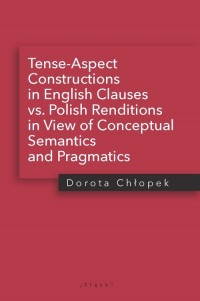Tense-Aspect Constructions in English Clauses vs. Polish Renditions in View of Conceptual Semantics
Dorota Chłopek

| Dane szczegółowe: | |
| Wydawca: | Wydawnictwo Naukowe ŚLĄSK |
| Rok wyd.: | 2020 |
| Oprawa: | miękka |
| Ilość stron: | 270 s. |
| Wymiar: | 160x235 mm |
| EAN: | 9788381830362 |
| ISBN: | 978-83-8183-036-2 |
| Data: | 2020-04-24 |
Opis książki:
The monograph deals with the tense-aspect constructions in English clauses and their Polish renditions in view of conceptual semantics and pragmatics. The accurate explanations of the differences between the grammatical and lexical aspects of situations described in the selected English sentences and their translatable Polish versions are thoroughly presented by the author. The differences concern in particular the perfect and the progressive aspects in English and the lack of corresponding aspects in Polish. That is why Polish has to transfer relevant English constructions grammatically.
prof. Ph Dr. Eva Malá, CSc., Book Review Report
Table of contents
Abbreviations and symbols
Preface
Introduction
Chapter 1: Cognitive Linguistics vs. Functional Linguistics - Selected Issues
1.1 A Symbolic Assembly as a Linguistic Construction in Cognitive Grammar
1.2 Cognitive Semantics as Encyclopedic Semantics in CL - Selected Issues
1.3 Conceptual Semantics in CL - Selected Constructs and Theories
1.3.1 Conceptual Frames
1.3.2 Cognitive Domains 1.3.3 Mental Spaces
1.3.4 Image Schemas
1.3.5 Conceptual Metaphor in Relation to the CONTAINER-Schema
and the PATH-Schema
1.3.6 Conceptual Blending Theory - Basic Aspects
1.3.7 Verb Satellites as Path-elements in the Bi-categorial Typology of
Languages
1.3.8 Outline
1.4 Cognitive Linguistics vs. Functional Linguistics: Selected Issues
1.5 Linguistic Corpus as a Connecting Methodological Tool between CL and Fn L
1.5.1 Selected Definitions of Linguistic Corpus in Fn L
1.5.2 Corpus Linguistics - Corpus-Based and Corpus-Driven Research
1.5.3 Outline
Chapter 2: Grammar and Semantics of English TA Constructions
2.1 Tense and Temporality in English
2.1.1 Tense - preliminaries
2.1.2 Tense vs. temporality and the two levels of Wada s Compositional
Tense Theory
2.1.3 Absolute tense vs. relative tense in English
2.1.4 On selected distinctions within English tenses
2.1.5 On the "twelve tenses" in Reichenbach (1947)
2.1.6 Tense/(Aspect): English vs. Polish
2.1.7 Outline
2.2 Aspect vs. Aspectuality
2.2.1 Grammatical Aspect
2.2.2 Lexical Aspect
2.2.3 Lexical Aspect with Reference to Croft s Classification 2.2.4 Viewpoint Aspect in English vs. Polish
2.2.5 Polish Verb Prefixes and English Verb Particles as Satellites in the
Motion Event
2.2.6 Lexical Aspect in Path-satellites: English Verb Particles vs. Polish Verb Prefixes
2.2.7 Determinate verbs vs. Indeterminate verbs in Polish
2.3 Polish Verb Prefixes and Other Derivatives (based on H. Wróbel, 1999; 2001)
2.3.1 Prefixed Derivatives
2.3.2 Inflectional Derivatives and Minus-Postfixal Derivatives
2.3.3 Prefix Formants as Aspectual Derivatives
2.4 Tense-Aspect Constructions in English vs. Polish - Outline
Chapter 3: TA Constructions in English Clauses Expressed in Polish: The Case Study
3.1 Perfective (Past) and Perfect Aspects
3.1.1 Past-Perfective Situations
3.1.2 Present-Perfect Situations
3.1.3 Past-Perfect Situations
3.2 Progressive Aspect
3.2.1 Present-Progressive Activities
3.2.2 Past-Progressive Activities
3.2.3 Past-Progressive Statives
3.3 Perfect-Progressive Aspects
3.3.1 Present Perfect-Progressive Activities
3.3.2 Past Perfect-Progressive Activities
3.3.3 Inactive Perfect-Progressive Activities and Statives
3.4 Imperfective Nonprogressive Situations
3.4.1 Habitual and Characteristic Activities
3.4.2 Present Statives
3.5. Outline
Conclusions
References
Bibliography
Internet sources
Doctoral dissertations
Selected works cited in other sources
Power-Point presentations
The dictionaries used
The sources of the examples cited in Chapter 3
Author Index
Książka "Tense-Aspect Constructions in English Clauses vs. Polish Renditions in View of Conceptual Semantics" - Dorota Chłopek - oprawa miękka - Wydawnictwo Naukowe ŚLĄSK. Książka posiada 270 stron i została wydana w 2020 r.

